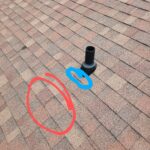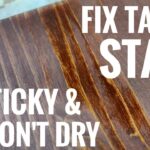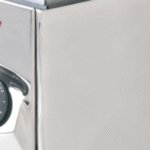Have you ever spent hours applying polyurethane to your wooden surfaces, only to find them feeling sticky and tacky long after they should have dried? If this sounds familiar, you’re not alone.
Many DIY enthusiasts and professionals alike have encountered this frustrating issue. But don’t worry, there’s hope. In this guide, you’ll discover the simple steps to transform your sticky polyurethane problem into a smooth, flawless finish. Imagine running your fingers over a surface that feels as good as it looks.
By understanding the common causes behind this stickiness and learning effective solutions, you’ll be able to rescue your projects and restore their beauty. Stick around and see how easy it is to fix sticky polyurethane once and for all!

Credit: www.ebay.com
Causes Of Sticky Polyurethane
Sticky polyurethane can ruin a beautiful finish. Understanding its causes helps in prevention. Several factors contribute to this problem. Environmental conditions, application mistakes, and product quality play major roles. Knowing these can save time and effort.
Environmental Factors
Humidity affects polyurethane drying. High moisture levels slow down the process. This leads to a sticky surface. Cold temperatures also impact drying. Polyurethane needs warmth to cure properly. Ensure the working area is dry and warm.
Application Errors
Applying too thick a coat causes issues. Thin layers dry faster and more evenly. Overlapping layers result in uneven drying. Use even strokes for a smooth finish. Proper technique prevents stickiness. Follow instructions carefully for best results.
Product Quality Issues
Low-quality polyurethane might not cure well. Cheap products often lack essential ingredients. This affects drying and durability. Choose high-quality brands for better results. Check product reviews before purchasing. Quality impacts the final finish.
Assessment Before Fixing
Assessing the condition of your sticky polyurethane is a crucial first step before jumping into solutions. Understanding what went wrong can save you time and effort. It’s like solving a puzzle; each piece leads you closer to the answer.
Identifying Severity
Start by observing the affected area. Is it slightly tacky or completely wet? Touch the surface lightly; does your finger stick or glide smoothly? If you find a small sticky patch, your fix may be simple. However, if the entire surface is sticky, a more comprehensive approach might be needed.
Consider the environment where the polyurethane was applied. Was it too humid or cold? These conditions can slow down curing and result in a sticky finish. Reflecting on the application process can uncover key insights.
Testing For Cure Time
Check the manufacturer’s instructions for the recommended cure time. Sometimes, we’re all guilty of impatience, expecting results too soon. Have you waited long enough? A few more days might be all it needs to dry completely.
If the curing time has passed and the surface remains sticky, try a small test. Apply a thin coat on a piece of scrap wood and watch how it cures. This can reveal whether the issue lies with the product or the application technique.
Have you ever rushed a project only to find yourself redoing it? Taking the time to test and assess can prevent future mishaps. What lessons have you learned from past experiences that you can apply here?
Remember, patience and observation are your allies in fixing sticky polyurethane. What will you discover in the assessment process that will lead you to a successful fix?
Surface Preparation
Surface preparation is the key to solving the sticky polyurethane dilemma. Before diving into repairs, it’s crucial to ensure the surface is perfectly prepped. A well-prepared surface can mean the difference between a flawless finish and a tacky disaster. Let’s look at how you can clean and sand your area effectively.
Cleaning The Area
Before any sanding, make sure your area is clean. Dust, grease, and old finishes can affect the adhesion of polyurethane. Use a mild detergent and a damp cloth to wipe down the surface. This removes any debris that might cause imperfections later.
Don’t forget to dry the surface thoroughly. Water residue can interfere with the polyurethane’s drying process. You might notice streaks or uneven patches if the surface isn’t dry.
Imagine spending hours on a project only to have it ruined by a few specks of dust. A clean start sets the stage for a smooth finish. Wouldn’t you want your efforts to shine?
Sanding Techniques
Once the area is clean, it’s time to sand. Start with a fine-grit sandpaper to gently scuff the surface. This helps the polyurethane adhere better. Light sanding prevents damage to the wood while ensuring the new finish sticks properly.
Don’t rush this step. Sanding thoroughly prepares the surface for the best results. Focus on maintaining even pressure to avoid uneven marks.
After sanding, wipe the surface with a tack cloth. This removes any remaining dust particles. Have you ever noticed how a tiny speck can mar a perfect finish? Tack cloths ensure every speck is gone.
Proper surface preparation is your first line of defense against sticky polyurethane. By cleaning and sanding with care, you set yourself up for a smooth, professional result. Is your project ready for the next step in achieving that flawless finish?

Credit: www.alibaba.com
Chemical Solutions
Fixing sticky polyurethane involves cleaning the surface gently. Use mineral spirits to remove excess residue. Allow the surface to dry completely for a smooth finish.
When dealing with sticky polyurethane, chemical solutions can be a lifesaver. They offer a practical approach to resolve this common issue, making your surfaces smooth and usable again. Using the right chemicals not only saves time but also ensures the quality of your finish.Using Solvents
Solvents are often the first line of defense against sticky polyurethane. They work by breaking down the tacky layer, making it easier to remove. Mineral spirits and naphtha are popular choices for this task. Here’s a simple way to use them: 1. Dampen a clean cloth with the solvent. 2. Gently rub the sticky area. 3. Wipe with a dry cloth to remove any residue. It’s essential to test the solvent on a small area first. This ensures it won’t damage or discolor your surface. Have you tried using solvents before? If not, it might just be the solution you need.Applying Thinners
Thinners can also help fix sticky polyurethane by diluting and leveling the finish. They work best when the stickiness results from the product being too thick or applied in a humid environment. Lacquer thinner is a common choice for this. To apply, follow these steps: – Mix a small amount of thinner with the polyurethane in a separate container. – Use a clean brush to apply a thin coat over the sticky area. – Allow it to dry completely. Using thinners can be a game-changer, but it’s important to use them sparingly. Too much can compromise the finish. Does this method sound like something you’d try? It could be the key to achieving a flawless finish. Chemical solutions can be incredibly effective in fixing sticky polyurethane, but they require careful application. Whether you’re using solvents or thinners, a bit of patience and precision can go a long way. What’s your go-to method for tackling sticky surfaces?Mechanical Methods
Fixing sticky polyurethane can be achieved with mechanical methods like sanding or scraping. These techniques help remove the tacky surface, leaving a smooth finish. Ensure proper ventilation and safety gear during the process for optimal results.
When dealing with sticky polyurethane, mechanical methods can be a game-changer. These techniques involve physical action to smoothen and fix the tacky surface. Whether you’re restoring an old piece of furniture or fixing a DIY mishap, mechanical methods can help you achieve a smooth, professional finish. They require a bit of elbow grease but are effective and satisfying. Let’s dive into two popular mechanical methods: scraping techniques and buffering and polishing.Scraping Techniques
Scraping off sticky polyurethane can be an efficient way to remove excess material and start fresh. Use a plastic scraper or a putty knife to carefully lift the sticky layer. Be gentle to avoid damaging the wood beneath. A light touch is crucial here, as pressing too hard might gouge the surface. Consider the angle at which you hold the scraper; a lower angle can help prevent scratches. Have you ever tried using a credit card as a scraper? It can be surprisingly effective on smaller surfaces!Buffering And Polishing
Buffering and polishing involve using abrasive tools to smooth out the sticky finish. Start with fine-grit sandpaper to gently rub the surface. This helps remove the sticky layer without harming the underlying wood. Once the surface feels smoother, switch to a polishing pad. A soft cloth or an electric buffer can work wonders here. Apply a bit of pressure and polish in circular motions to achieve a glossy finish. After polishing, wipe the area with a clean cloth to remove any dust. This step ensures that the surface is ready for a fresh coat of polyurethane if needed. A little patience and the right tools can transform your sticky disaster into a beautiful, smooth finish. Isn’t it fascinating how a little bit of mechanical work can bring out the best in your project?Reapplication Strategies
Reapplying polyurethane can fix sticky surfaces. It ensures a smooth finish. Incorrect application often causes stickiness. Understanding reapplication strategies helps. It guarantees better results.
Choosing The Right Polyurethane
Select the right polyurethane for your project. Water-based options dry quickly. They are ideal for indoor projects. Oil-based types offer durability. They are suitable for high-traffic areas. Always check the label. Ensure compatibility with your surface.
Proper Application Techniques
Start by cleaning the surface. Remove dust and debris. Use a clean cloth for this. Stir the polyurethane gently. Avoid shaking the can. This prevents bubbles. Apply thin layers with a brush or roller. Thick coats lead to stickiness. Allow proper drying time between coats. Usually, 24 hours is sufficient. Read instructions for specific drying times. Ensure proper ventilation. Good airflow speeds up drying. Avoid applying in humid conditions. Humidity slows down the process.
Preventive Measures
Preventing sticky polyurethane is easier than fixing it. Proper care ensures a smooth finish. Understanding preventive measures can save time and effort. Let’s explore some effective strategies.
Optimal Environmental Conditions
Temperature affects polyurethane drying. Keep the room between 65 and 75°F. Humidity should be low. High humidity slows drying. Ensure good air circulation. Open windows or use fans. Avoid applying polyurethane in damp conditions. Moisture can cause stickiness.
Correct Storage Practices
Store polyurethane in a cool, dry place. Seal the container tightly after use. Air exposure causes hardening. Keep away from direct sunlight. Heat affects the consistency. Use the product before its expiration date. Old polyurethane may not dry properly. Shake the container gently before use. This ensures even distribution of ingredients.
Expert Tips
Dealing with sticky polyurethane can be challenging. Yet, fixing it is possible with expert guidance. The right approach ensures a smooth, professional finish. This section offers expert tips to tackle sticky polyurethane issues effectively.
Professional Advice
Start by checking the humidity. High humidity affects drying time. Aim for a controlled environment. Use a dehumidifier if necessary. Ventilation is crucial. Ensure air circulation to speed up drying. Consider using a fan. A fan helps maintain airflow. Temperature also plays a role. Warm temperatures aid drying. Keep the workspace warm, but not hot. Use a thermometer to monitor.
Common Mistakes To Avoid
Applying thick coats is a common mistake. Thinner coats dry faster and more evenly. Be patient between layers. Rushing leads to a sticky finish. Always follow the recommended drying time. Ignoring it causes problems. Another mistake is neglecting preparation. Clean the surface thoroughly. Dust or oil affects adhesion. Use a tack cloth for dust removal.
Overusing a solvent is problematic. Solvents can break down polyurethane. Use them sparingly. Choose the right type of brush. A synthetic brush works best. It applies the polyurethane evenly. Finally, check the product’s expiry date. Old polyurethane may not dry properly. Always use fresh materials for the best results.

Credit: www.reddit.com
Frequently Asked Questions
Why Is My Polyurethane Sticky After Application?
Sticky polyurethane often results from improper curing. High humidity or low temperatures can slow the drying process.
How Can I Speed Up Polyurethane Drying?
Increase room temperature and reduce humidity. Use fans to improve air circulation and speed up drying.
What Should I Do If Polyurethane Remains Tacky?
Sand the surface lightly and reapply a thin coat. Ensure proper drying conditions for the new layer.
Can Sticky Polyurethane Be Repaired Without Sanding?
Yes, apply mineral spirits using a cloth. This can help remove tackiness without damaging the finish.
How Long Does Polyurethane Take To Dry Completely?
Polyurethane typically dries in 24 hours. However, full curing may take several days, depending on conditions.
Conclusion
Fixing sticky polyurethane is simpler than it seems. Start by checking the humidity. High moisture can cause stickiness. Use a dehumidifier if needed. Ensure proper ventilation. Open windows or use fans. Sand the sticky areas gently. Apply a fresh coat sparingly.
Let it dry completely. Patience is key. Follow these steps to enjoy a smooth finish. Your project will look and feel great. Keep these tips handy for future use. Prevent sticky polyurethane with good practices. Your woodworking skills will improve over time.
Always keep learning and experimenting.





